Mounting a super-low profile tire onto a large diameter rim can present unique challenges. Dealing with ultra-short (and stiff) sidewalls can prove difficult when using conventional mounting approaches. In order to complete the task and avoid rim damage at the same time, follow these tips to guide you through this sometimes anguishing job.
THE EQUIPMENT
Try pushing an unforgiving rock of a tire onto a large, delicate and expensive alloy wheel, and you´ll begin to appreciate the difficulties involved in mounting today´s 45-, 40-, 35- and 30-series performance tires. The short and stiff sidewalls featured on these lowest of low-profile rubbers require specific techniques and equipment for successful mounting.
Due to the minimal compliance of many of these tires, "slipping" the beads over the rim of a mammoth-diameter, finely finished alloy wheel is anything but simple and straightforward. One "oops" with the tire iron, or one hiccup of an outdated changer machine can turn the expensive aluminum wheel into a poster child for the scrap metal industry.
To get a first-hand look at mounting one of these rubber band-like low-profile tires, we visited Mueller Tire & Brake´s Hudson, Ohio, store location and mounted a 275/35ZR18 tire onto an 18x8.5-inch alloy rim.
In terms of selecting a changer for this type of job, bear in mind that we´re dealing with potentially high forces in terms of forcing the bead over the rim. In order to complete the task successfully and to avoid rim damage, the changer must provide a positive anchoring system that reduces the risk of rim damage. Some older style rim-clamp machines with overhead swing arms may not be up to the job, since the vertical drop-arm may deflect and jam its bead guide into the rim as the machine attempts to force the stiff bead over the rim. This can result in scraping -- or breaking -- the wheel rim, and can add a good deal of frustration to the process.
We´re not trying to promote one machine over another, although for purposes of this article, we used Mueller´s Hunter TC 3250 changer and McCourt´s MTS 2010-20 HP, a private brand tire changer made for Myers Tire Supply Co.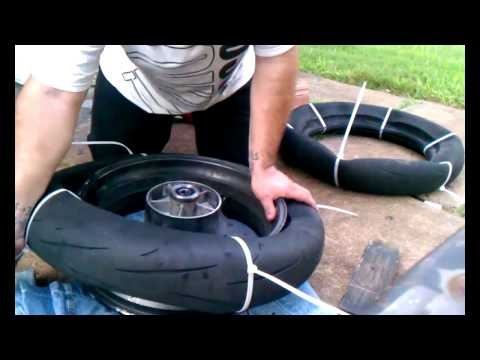 by Corghi. These are good examples of the types of machines appropriate for this work.
by Corghi. These are good examples of the types of machines appropriate for this work.
In both cases, the wheel is secured to the turntable fixture via a set of expanding arms that feature rubber contact pads. Providing the pads are clean and free of contaminants, the changers will secure the wheel solidly without marking the rear inner walls of the wheel.
[PAGEBREAK]
THE PROCESS
The following step-by-step mounting instructions will give you an idea on just how careful you have to be in order to mount low-profile tires. Keep in mind, however, that the Hunter TC 3250 is the changer of record here. Some of its features differ from those of other changers, including the MTS 2010-20 HP, which clamps onto the rim from the outside in.
After checking that the changer´s expander rubber pads are clean, the wheel is placed over the spreader fixture and the spreader arms are expanded, allowing the rubber pads to securely hold the wheel in position.
With both the inboard and outboard tire beads lubricated, the rear bead is slipped over the outer rim with the aid of the machine´s bead guide.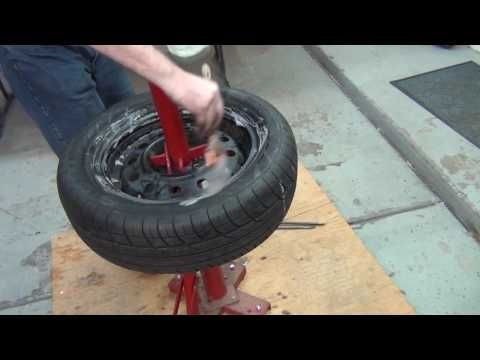 The machine´s bead guide is lowered over the tire bead, and the bead is initially slipped over the guide´s spoon. The mechanical bead pusher is then positioned downward onto the stubby sidewall.
The machine´s bead guide is lowered over the tire bead, and the bead is initially slipped over the guide´s spoon. The mechanical bead pusher is then positioned downward onto the stubby sidewall.
At this point, a bead depressor tail is installed, which will prevent the tire bead from popping off of the rim as the wheel rotates clockwise.
This type of bead hold-down device is wonderful, especially when dealing with stiff-sidewall, low-profile tires that tend to otherwise jump off the rim as the wheel rotates on the machine. The bead depressor tail was designed specifically for dealing with run-flat tires and ultra-low-profile performance tires. It´s like having four or five hands and tire irons to keep the bead down during the front bead slip-over process.
The tool features a center vertical anchor that slips through the wheel hub hole and inserts into the machine´s center pad.
The first depressor clamp is attached to a horizontal sliding arm that locates the rubber clamp rigidly, providing an initial hold-down spot. As the rim rotates, the next clamp is installed, followed by the next, etc. This provides a series of anchors that prevent the tire bead from popping off the rim as the remaining tire bead is guided by the machine´s bead guide. While a clean tire iron is used as an aid, this specialty tool eliminates the need to use only irons to continue the guiding process. It´s a very slick approach, and solves the dilemma of manually forcing a stiff sidewall tire into position over the wheel rim.
As the rim rotates, the next clamp is installed, followed by the next, etc. This provides a series of anchors that prevent the tire bead from popping off the rim as the remaining tire bead is guided by the machine´s bead guide. While a clean tire iron is used as an aid, this specialty tool eliminates the need to use only irons to continue the guiding process. It´s a very slick approach, and solves the dilemma of manually forcing a stiff sidewall tire into position over the wheel rim.
Once the machine´s turntable has rotated far enough to install all of the depressor tail´s rubber clamps along the rim perimeter, the turntable only needs to rotate a few inches further in order to pop the remaining bead behind the rim. The depressor tail assembly is then removed.
This may seem like a simple procedure, and that´s exactly the point. If you have access to the correct type of equipment and specialty tools, the job is not difficult. What took a few minutes in this example could have taken hours with inappropriate tools, and the likelihood of rim damage would have been significant.
[PAGEBREAK]
MOUNTING BASICS
Keep in mind that when dealing with expensive custom wheels and high performance tires, the customer will be extremely sensitive to both cosmetics as well as performance. In order to avoid nicking, scratching or gouging a rich alloy wheel, a few basic precautionary steps must be followed.
1. Make sure the mounting machine and all specialty tools that will be used in the job are clean and free of burrs.
2. Whenever dealing with expensive alloy wheels, avoid using bare steel or iron clamping jaws, as these will easily scratch or gouge the wheel. Chances are the customer who values his high performance tires and wheels will not be pleased even if this cosmetic damage takes place on the inboard side of the wheel.
Always use rubber or plastic jaws or jaw protectors to avoid damage while clamping the wheel to the machine´s turntable. If the jaws feature rubber pads, make sure the pads are free of imbedded metal chips.
3.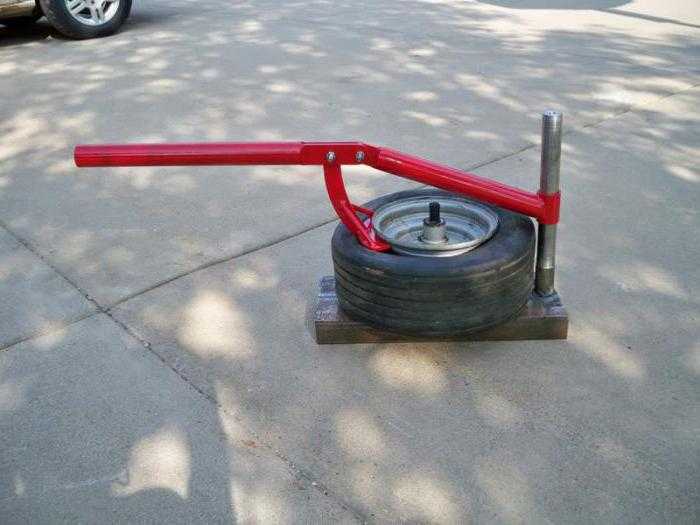 Always install a new valve assembly into the wheel, regardless of its apparent condition.
Always install a new valve assembly into the wheel, regardless of its apparent condition.
4. Clean the wheel´s bead seat surfaces if the wheel has been previously mounted. Remove any rubber, corrosion or grime deposits that might hinder bead sealing.
Make sure the bead lubricant is clean, and that the lube brush is free of debris.
5. Once the tire has been positioned onto the wheel, place the machine´s air hose locking-type chuck onto the valve, and stand to the side of the machine during initial seating inflation. Always wear safety glasses or goggles, and never stand directly over the tire/wheel during inflation.
6. Use a maximum of 40 psi to seat the beads. Once the beads have fully seated, remove the hose chuck and allow the air pressure to escape from the tire before inserting the valve core. Note: Check to make sure that both the inboard bead has fully seated as well. Even if the outboard bead has seated, it is still very possible that the inboard bead has not been fully positioned against the rear bead wall of the wheel.
Remember, these tires can be very stiff, and because they´re not as compliant as taller-sidewall tires, you can´t assume that both sides have popped out against their seats.
7. Always insert a new valve core, and be sure to properly snug the core into the valve. Re-inflate the tire to 40 psi. Apply a solution of clean soapy water along the bead-to-rim area to check for leaks. If bubbles are noted, this may indicate that the bead is not fully seated in that area, or that a small piece of debris is lodged between the tire and wheel. Re-inflate once again checking for leaks.
[PAGEBREAK]
MATCH MOUNTING
As a result of the manufacturing process when either wheels or tires are made, it is not uncommon to feature a very slight variation in the radial shape of either part. If the wheel and/or the tire has enough radial runout (variation from a true concentric), radial force variation can occur, wherein a "high" spot of the tire pounds the pavement during operation at speed.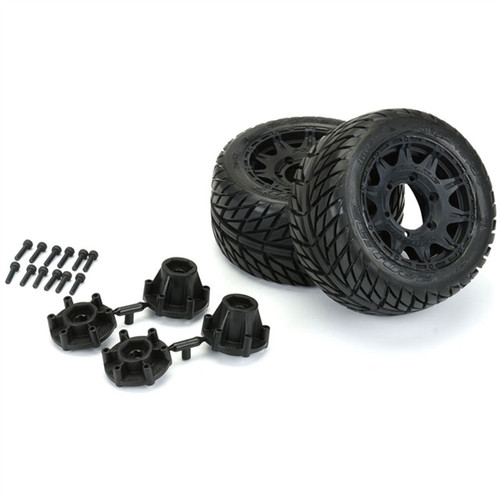 Bear in mind that force variation is not necessarily a weight/mass problem, but rather a radial shape problem. In other words, balancing may not cure this type of vibration. A process called "match mounting" involves finding the ideal compromise between the high spot of the tire and the low radial spot of the wheel.
Bear in mind that force variation is not necessarily a weight/mass problem, but rather a radial shape problem. In other words, balancing may not cure this type of vibration. A process called "match mounting" involves finding the ideal compromise between the high spot of the tire and the low radial spot of the wheel.
By mounting the tire onto the wheel so that the wheel low spot and the tire high spot align, the potential for a radial force variation (vibration at speed) is minimized or eliminated, as the two high/low areas tend to cancel each other out.
If the tire features a color dot (indicating the high spot), this color dot may be aligned with either the wheel´s color dot (indicating the wheel low spot) or with the wheel´s air valve.
Another accurate method involves actually measuring the wheel and the tire in order to locate each component´s radial variation area. Using a Hunter GSP 9700 balancing machine as an example, the bare wheel may be mounted onto the machine´s axle shaft. A built-in electronic runout indicator is placed onto the wheel´s bead seat area.
A built-in electronic runout indicator is placed onto the wheel´s bead seat area.
As the wheel slowly rotates, the machine locates the wheel´s low spot. After marking this spot with chalk or a crayon, the tire is then mounted onto the wheel and spun on the machine using the built-in road wheel simulator. This applies force against the tread as the tire rotates, allowing the machine to electronically determine the mounted and inflated tire´s high spot. Once this spot is located and labeled (with chalk), the tire is then deflated, the beads are "broken" (separated from the wheel), and the tire is rotated on the wheel to align the two marks. The tire is then re-inflated, seating the tire beads. Now the assembly may be spin-balanced to correct for any weight mass bias.
This process may be time consuming, but it´s absolutely the correct method in achieving an optimized package for either the enthusiast or for correcting a nasty vibration problem that conventional balancing may not be able to solve.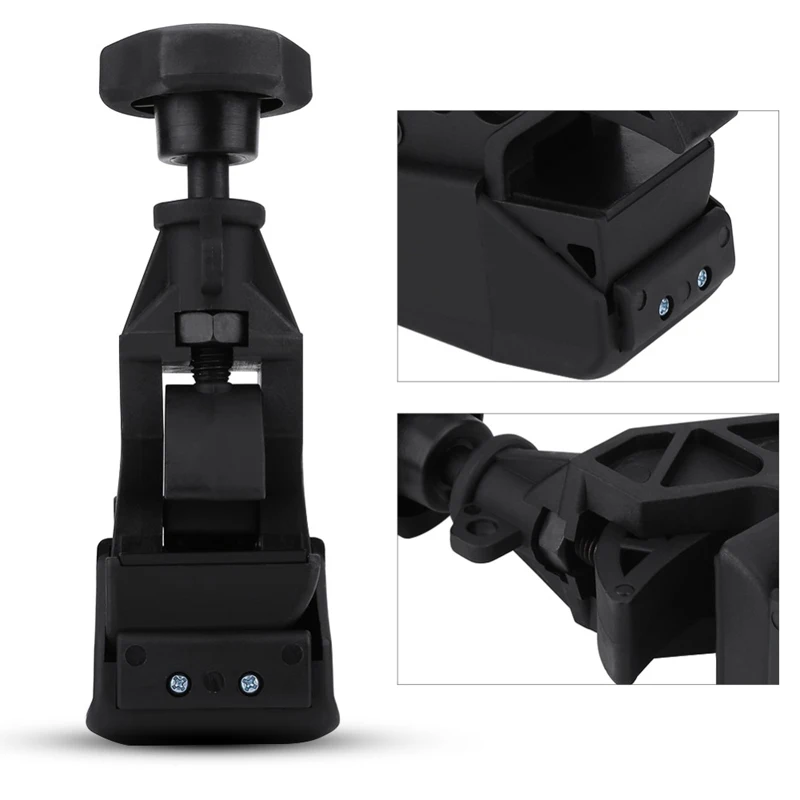
If you’re making enhancements to your vehicle’s appearance, it’s likely that your first purchase will be new tires and wheels. This alteration alone can transform a car from “meh” to “yeah” without a huge labor investment.
One of the more popular upgrades is the replacement of ordinary wheels with much larger versions. The use of low-profile tires allows the larger rims and wheels to fit inside standard wheel wells without rubbing on turns.
If your vehicle didn’t come with low-profile tires, you can still achieve the look and performance aspects of these tires by using larger wheels on your vehicle. If you’re one of the five kinds of people described below, low-profile tires are a good enhancement to add to your favorite ride.
You Want the Big Wheel Look
Some drivers stretch too-small tires onto larger wheels to get the look they want. This method of tire-mounting is known to shred tires. Any overstretched tires that don’t shred are still vulnerable to full-on, random blowouts.
However, drivers can now have the look they want without great risk. Manufacturers offer low-profile and specialty tires meant to fit larger rims. You don’t have to sacrifice safety for style.
You Want Better Handling
Buy track-ready high-performance tires fitted with custom 20-inch wheels for true grip and curve finesse. Many race-worthy styles of tires are also street legal.
Be aware that changes in wheel size can affect your suspension, brakes, power steering, odometer, and speedometer. You may see an increase in fuel use with increasing sizes of rims, but your acceleration times will decrease slightly as wheels increase in diameter.
The shorter wheel sidewalls on the tires allow them to handle curves more responsively. Short sidewalls flex less than standard-size sidewalls, so the handling tends to improve when bigger tires are replaced. This is true especially in cars that are not known for the most graceful moves on curvy roads.
You Show Off Your Vehicle
At car shows and rallies, the winners take the time to pay attention to the details. Your vehicle’s look is partially determined by its “stance,” or the way it carries itself on the tires.
Your vehicle’s look is partially determined by its “stance,” or the way it carries itself on the tires.
A tiny adjustment of angle on your rims can change the entire look of the car. The adjustment makes awesome wheels stand out too.
Using low-profile tires ensures that fancy custom wheels are featured prominently. Angling the tires in or out can give your car personality and sass, but angling is best accomplished with low-profile tires.
You Live Where Roads Are Smooth
Low-profile tires have stunning, short sidewalls that give them lots of responsiveness on curvy roads. However, these tires’ lack of flexibility and shorter width make them vulnerable to damage from the road.
If you live in an area where the roads are well maintained, this isn’t a problem. If you plan on driving the car only occasionally or only on smooth roads, you’re also fine.
If you live where there are plenty of potholes, road debris, and constant construction projects going on, low-profile tires are not the best choice for you unless you have a generous tire allowance in your budget.
You Don’t Care Much About a Smooth Ride
Comfort is often sacrificed when you make the switch from standard tires to low-profile tires. All of that extra height in the larger sidewalls give standard tires a cushioning effect when the rest of the car is well maintained.
Low-profile tires have a larger “contact patch” with the road, so they grip better, but they also convey every bump and crack in the pavement to the riders in some vehicles. If you don’t mind a firm ride with some bumps and jiggles, low-profile tires will work for you.
Always check the laws where the car is registered to make certain you’re permitted to make desired wheel changes. Legislation may limit your choices for wheel modifications. Invest in high-quality tires and reduced-weight rims made by reputable manufacturers no matter which styles of wheels and tires you choose for your vehicle upgrade.
Trust Evans Tire & Service Centers to help you choose the most stylish and high-performance tires for your ride. Our ASE techs are happy to answer your questions about wheels and tires, and they look forward to helping you achieve the look you want for your vehicle.
Our ASE techs are happy to answer your questions about wheels and tires, and they look forward to helping you achieve the look you want for your vehicle.
Do you dream of instantly giving your car an aggressive and stylish look in one movement? Quite a lot of motorists solve this issue very simply - they change factory tires and wheels for low-profile rubber and casting, and the main criterion for such a choice is “just want to!”. However, before deciding on such a serious and very expensive step, it is imperative to take into account all the disadvantages and advantages of installing low-profile wheels on a car. nine0003
Low profile tires are tires that have a wheel profile height to width ratio of less than 55. These wheels are most often found on sports cars, but some owners of large SUVs also prefer to install wheels with low profile tires on their jeeps.
Low profile rubber wheels are almost ideal for top speeds on smooth and level roads. Due to their width, low-profile wheels have a stronger grip compared to standard-sized wheels. A car fitted with low-profile rubber tires becomes much more controllable when braking, more confidently passing through any turns. nine0003
Due to their width, low-profile wheels have a stronger grip compared to standard-sized wheels. A car fitted with low-profile rubber tires becomes much more controllable when braking, more confidently passing through any turns. nine0003
Well, the disadvantages of wheels made of such rubber include its increased wear, especially on roads with poor coverage. If a car with such wheels "flies" through pits and potholes without slowing down, then the average life of the rubber is significantly reduced. Taking into account the rather considerable cost of wheels with low profile tires, this moment immediately turns into a very fat minus.
Any roads with poor coverage are very detrimental to the running component of the car. And if it also has low-profile tires, the car will be much tougher to overcome road bumps. In this case, we get the following: that the lower the profile of the installed rubber, the less the impact is absorbed, and the stronger the impact on the chassis of the car. Both the driver and passengers will feel this very well, the car will shake quite sensitively on any hole or bump. Also, a minus can be attributed to the fact that the wheels of low-profile rubber, when the car is moving, emit increased noise. nine0003
Both the driver and passengers will feel this very well, the car will shake quite sensitively on any hole or bump. Also, a minus can be attributed to the fact that the wheels of low-profile rubber, when the car is moving, emit increased noise. nine0003
These moments, the owners of cars with low-profile tires, retort by the fact that in the city you can move on more or less flat roads. Well, if you have to get out onto a heavily broken track, then you just need to very carefully, at minimum speed, go around all the road pits and bumps. Without slowing down in time, even on a small pothole, it is quite possible to instantly damage the low-profile rubber, and sometimes even split the rim.
When choosing this type of tires for a car, experts advise to take into account any recommendations from automakers. All of the above negative points may seem rather insignificant for the category of wealthy car enthusiasts, but they can easily scare away owners of budget cars. The most important thing is to remember about safety on the road when choosing and installing any tires. nine0003
nine0003
Some people prefer classic tires with a standard profile, while others prefer narrow profile tires. What justifies the choice of low profile rubber, what features does this type of tuning have, what advantages and disadvantages can be identified? We talk about all this in detail in the article.
To determine whether a tire has a low or standard profile, it is necessary to measure three parameters - the height, the width of the profile, and the diameter of the disk itself. The complexity of the selection of tires lies in the fact that these parameters are interconnected. That is, by changing one value, it is necessary to adjust other values according to the manufacturer's recommendations. nine0003
The calculation formula is: Height/Width * 100%.
The values obtained show the relationship between the two quantities, but are not the absolute result of the calculations. That is, when choosing tires for an off-road vehicle, we can only say with certainty that the sidewall height of 205/55 R17 will be lower than that of 225/55 R17.
That is, when choosing tires for an off-road vehicle, we can only say with certainty that the sidewall height of 205/55 R17 will be lower than that of 225/55 R17.
What is narrow profile tyre? This is a tire in which the height of the sidewalls, when measured from the roadway to the disk, has a minimum value in relation to the width. nine0003
Narrow profile tires differ even in appearance from classic tires. To find out the main parameters, you need to look at the side surface, where a special marking is applied. For example, consider the standard tire marking 205/55 R17:
Low profile tires have a height to width ratio of 0. 55 or less. In the above example, the tire marking is already considered narrow-profile. It is allowed to lower the profile as much as possible to a ratio of height and width of 0.2.
55 or less. In the above example, the tire marking is already considered narrow-profile. It is allowed to lower the profile as much as possible to a ratio of height and width of 0.2.
Low-profile wheels also differ in the index of permissible speed. This value is indicated in the marking on the sidewall. If standard tires have a limit of 190 km / h, then narrow-profile - 210 km / h. In such tires, the presence of a stiffener is mandatory, which protects the car disk from deformation.
As a rule, such tires are installed on a car to improve sports performance. The car moves faster, improves dry grip. In addition, a narrow profile is used for tuning cars. If you want to change your car and highlight it from the same type of flow, then this is one of the possible solutions. nine0003
As for the proper operation of such rubber, drivers have a lot of questions. For example, what pressure should be in low profile tires? In many tire services, they simply do not know how to pump low-profile tires and, in order to be safe, they make tire pressures of 2. 1-2.2 atm. As a result, the car drives on half-flat tires.
On average, it is recommended to pump at least 2.6 atm into tires for passenger cars. Depending on the parameters of the tire, the pressure of off-road tires can be 2.7-2.9atm.
Another common question is low-profile winter tires. Is it possible to use such rubber in winter or is it better to put the standard one? Winter tires differ from summer tires in the material of manufacture (softer), the presence of spikes, and the tread pattern. Accordingly, a narrow-profile tire is not suitable for driving in ice, heavy snow or on uneven and slippery roads. The wheels simply will not withstand the "surprises" of winter, and any unevenness will be given into the hands of the driver. nine0003
Low-profile off-road tires are on sale, and manufacturers also produce winter off-road tires. In any case, you should carefully consider the choice of such tires for operation in winter or in difficult road conditions.
Summer Drive Protection Run On Flat
Rating:
4.5
Tires Goodyear Eagle F1 Asymmetric
Summer Drive protection
Rating:
4.5
Tires Goodyear Eagle Sport TZ
Summer Drive Protection Run On Flat
Rating:
4.5
Tires Goodyear EfficientGrip Performance
Summer Drive protection
Rating:
5
Tires Goodyear EfficientGrip Performance 2
All season Drive Protection Run On Flat
Rating:
4. 5
5
Tires Goodyear Vector 4Seasons Gen-2
All season Drive Protection Run On Flat
Rating:
4.5
Tires Goodyear Vector 4Seasons Gen-3
Tires Goodyear UltraGrip Arctic 2
Winter Drive Protection Run On Flat Sound Comfort
Tires Goodyear UltraGrip Performance+
Winter Drive protection
Tires Goodyear UltraGrip Ice 2+
Consider a few of the main advantages of rubber with a narrow profile:

In addition to the advantages, tires with such a profile have a number of disadvantages. Consider the main ones: nine0003
It is necessary to highlight such a minus - the complexity of installation. It is impossible to install tires on your own. At least special equipment is required, but not all workshops have it. Also, the tire design itself adds a “smut” when choosing wheels. Often, tires simply do not meet factory requirements.
We examined what a narrow profile tire is. We learned what it is used for, studied the features of operation in summer and winter, determined how much atmosphere should be pumped into the tire.